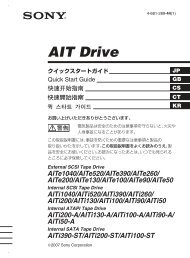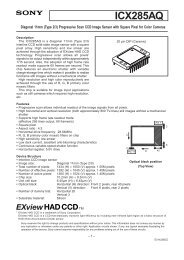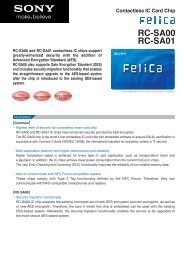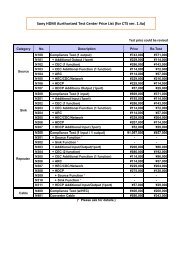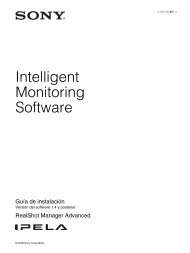PDF [4833KB] - Sony
PDF [4833KB] - Sony
PDF [4833KB] - Sony
You also want an ePaper? Increase the reach of your titles
YUMPU automatically turns print PDFs into web optimized ePapers that Google loves.
The future of key components<br />
To reinforce its competitive strength in its core electronics business, <strong>Sony</strong> is seeking to differentiate<br />
its products by implementing a vertically integrated business model that incorporates<br />
internally produced proprietary semiconductors, modules and components. Key components<br />
include Cell, a next generation, multi-purpose microprocessor; imaging components, such as<br />
CCDs and CMOS image sensors; display components, such as LCDs and organic electroluminescence<br />
(OEL) displays; Memory Stick; optical devices; and lithium-ion batteries. These<br />
components are essential for producing highly competitive products.<br />
Cell: The next generation, multi-purpose microprocessor<br />
Differentiating products by strategic<br />
component<br />
Over the years, <strong>Sony</strong>’s ability to develop such<br />
proprietary key components as Trinitron and<br />
CCD internally has been instrumental in creating<br />
numerous appealing products, and has<br />
been the foundation of <strong>Sony</strong>’s evolution.<br />
PlayStation 2 (PS2), for example, features the<br />
EmotionEngine (EE), a 128-bit CPU incorporating<br />
highly advanced technology, and the<br />
Graphics Synthesizer (GS), a high performance<br />
image processor. Since its debut, PS2 has<br />
revolutionized the game console market. As<br />
the vital role played by EE and GS in the<br />
success of PS2 showed, highly differentiated,<br />
advanced semiconductors are essential in order<br />
to open up new markets. Currently, <strong>Sony</strong> is<br />
developing a new microprocessor, Cell, which<br />
is ideally suited for the upcoming era when<br />
the proliferation of broadband networks will<br />
enable people everywhere to enjoy highresolution<br />
images.<br />
The heart of next generation digital<br />
consumer electronics<br />
The concept behind Cell is to evolve the conventional<br />
microprocessor, which is more of a<br />
narrowband data processor that computes text<br />
and still images mainly for PCs into a broadband<br />
data processor for game consoles and<br />
high-definition televisions. Connecting several<br />
multiple processors using a home network or<br />
an IP broadband network will create a processing<br />
capability that far exceeds that of a single<br />
processor. The name Cell reflects <strong>Sony</strong>’s belief<br />
that stand-alone microprocessors will be connected<br />
through a broadband network and will<br />
evolve to become a single global processor, in<br />
the same way as organic cells combine to<br />
create a living organism. Accordingly, networkenabled<br />
devices, including consumer electronics<br />
equipped with Cell, will become a structural<br />
element of the broadband network itself.<br />
Strategic alliance with IBM and Toshiba<br />
expedites the development process<br />
In March 2001, the <strong>Sony</strong> Group reached an<br />
agreement with IBM Corporation and Toshiba<br />
Corporation to collaborate in research and<br />
development to create the architecture for a<br />
new microprocessor, Cell, which it envisions as<br />
the foundation of the next generation broadband<br />
network era. Combining their respective<br />
strengths and technologies, the three companies<br />
expect to invest more than $400 million in<br />
this project over five years. By incorporating<br />
several of today’s most advanced semiconductor<br />
manufacturing technologies, such as copper<br />
interconnects, a silicon-on-insulator (SOI)<br />
process and low-K dielectric material, the<br />
project aims to create a microprocessor that is,<br />
in effect, a supercomputer on a chip.<br />
Investment to facilitate production of<br />
semiconductors for 65 nanometer process<br />
technology—the most advanced in the world<br />
Preparations are under way to fabricate Cell<br />
and a variety of media processors in three<br />
locations: <strong>Sony</strong>’s Nagasaki Fab; an IBM manufacturing<br />
facility in East Fishkill, New York; and<br />
a Toshiba manufacturing facility in Oita, Japan.<br />
In the fiscal year ended March 31, 2004, the<br />
<strong>Sony</strong> Group recorded capital expenditure of<br />
about ¥69.0 billion for the first stage of<br />
construction of a mass-production facility for<br />
semiconductors that use 65 nanometer (one<br />
nanometer equals 1/1,000 of a micrometer)<br />
process technology. Additional capital expenditure<br />
of about ¥120.0 billion is planned for the<br />
second stage of construction, beginning in the<br />
fiscal year ending March 31, 2005. Trial operations<br />
at each of the three locations are scheduled<br />
to commence during the first half of<br />
2005. Combined monthly production capacity<br />
of the three facilities for 300mm wafers is<br />
expected to be approximately 15,000 wafers.<br />
18


![PDF [4833KB] - Sony](https://img.yumpu.com/26420643/20/500x640/pdf-4833kb-sony.jpg)

